Exploring the Diverse Habitats of the Caracal Cat
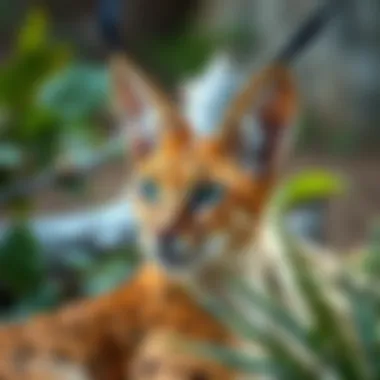
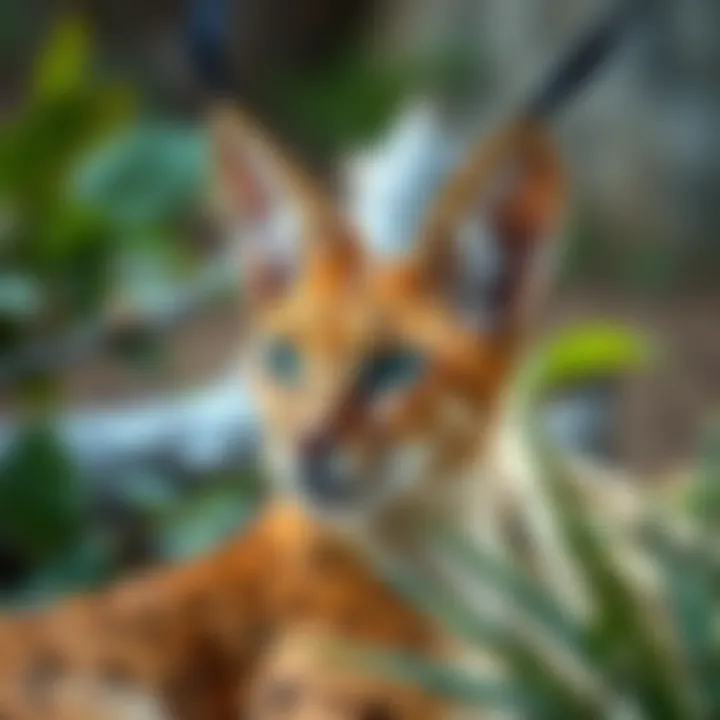
Animal Species Profile
Foreword to the Animal Species
The caracal, a striking medium-sized wild cat, is known for its sleek body and those unmistakable tufted ears that give it a unique charm. Often mistaken for lynx due to their ear characteristics, the caracal’s scientific name is Caracal caracal. It’s a fascinating creature that inhabits diverse regions across Africa, the Middle East, and parts of Central Asia. Caracals are not just about looks; they possess impressive hunting skills, adept at taking down prey much larger than themselves.
Physical Characteristics and Appearance
With a height ranging from 40 to 50 centimeters at the shoulder and weighing between 8 to 19 kilograms, the caracal stands out in its family. Its coat is typically a rich, reddish-brown, with lighter underbelly shades. The long tufted ears, reaching about 5 centimeters, contribute significantly to its acute hearing—vital for locating prey in the dense grasslands and rocky landscapes it often favors. Their eyes, amber and almond-shaped, enhance their keen sight, particularly adept in low-light situations.
Natural Habitat and Distribution
Caracals are quite versatile when it comes to habitat selection. They thrive in dry savannas, scrublands, and even mountainous regions. Their distribution stretches widely, from the vast terrains of sub-Saharan Africa through parts of the Arabian Peninsula to the rugged landscapes of Central Asia. Their adaptability often sees them near agricultural land, where they can prey on rodents and birds, but this brings them closer to human settlements, posing various risks.
Behavior and Social Interactions
Solitary by nature, caracals are not often seen in pairs, except during mating season or a mother caring for her young. They are primarily nocturnal hunters, using the cover of darkness to stalk and pounce on their prey. Their territories can span several kilometers, and they scent mark to communicate with neighboring caracals. Though could appear indifferent, they have a robust social structure when necessary, particularly during nurturing or territorial disputes.
"Caracals are nature's agile balance of beauty and efficiency, a creature that survives gracefully in varied landscapes."
Conservation & Wildlife Efforts
Overview of Conservation Status
The caracal is currently classified as Least Concern by the International Union for Conservation of Nature (IUCN). However, this status can be misleading as local populations are under threat from habitat loss and human-wildlife conflict. Their numbers have been declining in certain areas due to these factors, prompting the need for ongoing observation.
Threats to the Species
Human encroachment is the primary threat to caracals. As urban development expands, their natural habitat shrinks. Vehicle strikes and hunting often falter their survival in specific regions. Moreover, the use of poison to eliminate pest species can inadvertently harm caracals as well.
Conservation Initiatives and Organizations
Organizations like the Worldwide Fund for Nature (WWF) and Panthera are working to address the decline of caracal populations. They focus on habitat conservation and raising awareness about the species' importance. Local initiatives often involve community engagement, educating residents on coexistence strategies to reduce conflicts.
Success Stories and Impact
There have been positive outcomes in areas where conservation efforts are focused. For example, in South Africa, specific nature reserves have seen a rebound in caracal populations through dedicated protective measures and habitat restoration programs. These successes indicate that with the right approaches, the caracal’s future can still shine bright.
Animal Behavior & Psychology
Communication and Language Cues
Caracals are not overly vocal, but they communicate through a series of grunts, growls, and hisses, typically reserved for threats or during mating season. Body language plays a crucial role; the position of their ears and tail can signify aggression or submission.
Reproductive Behavior and Parenting
Mating typically occurs after a courtship display between males and females. The gestation period lasts about 60 to 70 days, after which a litter of one to six kittens is born. Mothers are fiercely protective, teaching their young essential hunting skills until they’re ready to fend for themselves at around 10 months of age.
Cognitive Abilities and Problem-Solving Skills
Caracals exhibit remarkable intelligence, often demonstrated through their hunting techniques. They strategize and employ various methods to outsmart their prey. Studies show they can remember locations of past hunts and adapt their strategy accordingly based on successes or failures.
Emotional Intelligence and Social Dynamics
While primarily solitary, caracals can exhibit a range of emotions. They form bonds with their young and are known to defend their offspring aggressively. This protective behavior indicates a deeper emotional capacity than often credited.
Unique Facts & Trivia
Little-Known Facts About the Animal
Did you know that caracals can leap up to three meters in the air to catch birds mid-flight? That’s a party trick worth knowing! They’re also known for their remarkable ability to adapt their hunting tactics depending on the environment.
Surprising Behaviors or Adaptations
Besides their impressive vertical leap, caracals have retractable claws that allow for silent movement—a significant advantage when stalking prey. They tend to avoid direct confrontation and prefer strategy over brute force.
Fun Trivia and Quirky Behaviors
Caracals occasionally display playful behavior when around their young or during solo playtime, using anything from twigs to small stones in their games. These moments offer a glimpse into their playful side.
Record-Breaking Feats or Abilities
Caracals are often recognized for their exceptional hunting prowess. They can take down animals three times their size, an impressive feat well-documented in various wildlife studies. Their skills make them one of the apex predators in their habitats.
Pet Care & Tips
Choosing the Right Pet for Your Lifestyle
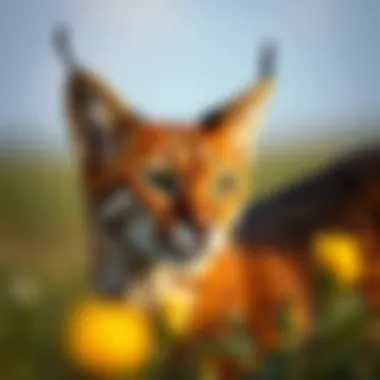
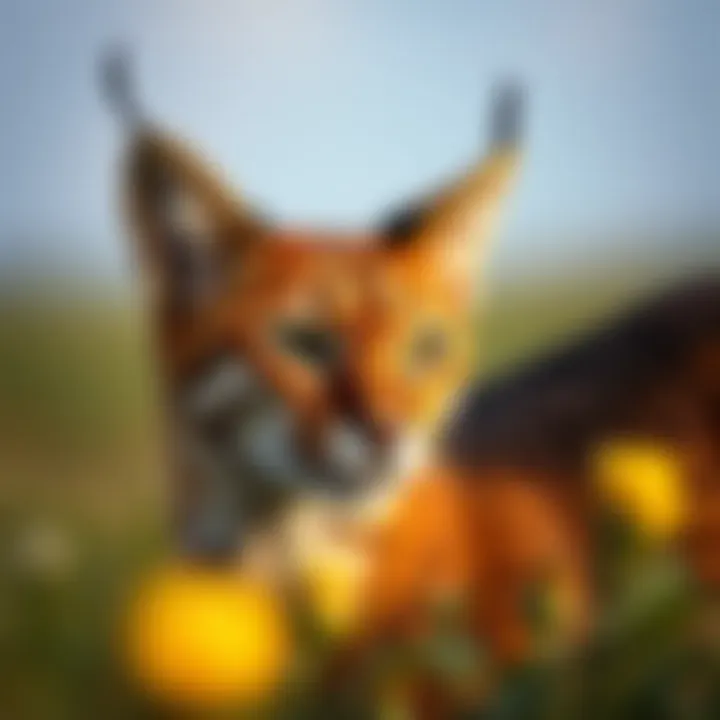
When considering pet ownership, ensure you do thorough research. Choosing an animal that suits your living conditions, time availability, and financial commitment is critical.
Basic Care Requirements and Habitat Setup
For pets, proper habitat setup includes appropriate space, environmental enrichment, and conditions mimicking their natural environment.
Health and Wellness Tips for Pet Longevity
Regular veterinary care, a balanced diet, and proper exercise are essential for an animal's longevity. Awareness of specific breed needs is critical in maintaining health.
Training Techniques and Behavioral Enrichment Ideas
Training pets requires consistency and patience. Engaging them in fun activities can enhance their mental stimulation. Implementing interactive games often leads to healthier, happier pets.
Learn more about Caracals on Wikipedia
For additional information on wildlife conservation, visit WWF or National Geographic.
Let’s understand the wild, protect it, and cherish the incredible creatures like caracals that share our world.
Prolusion to the Caracal
The caracal is a remarkable wild cat, recognized for its striking features and adaptability across varied landscapes. Understanding the caracal is crucial not only for ecology enthusiasts but also for anyone passionate about wildlife and preservation. Their presence indicates the health of their environment, while their behavior provides insight into the intricate balance of ecosystems. Through this section, readers will grasp the significance of the caracal as more than just a unique creature, but as a symbol of nature's resilience amidst changing landscapes.
Taxonomy and Physical Characteristics
The caracal belongs to the Felidae family, specifically classified under the genus Caracal. Its taxonomical classification places it alongside other wild cats, yet it stands out due to several unique characteristics. Notably, its tufted ears serve multiple functions, such as enhancing auditory perception and allowing for better communication with other caracals. Physically, the caracal showcases a robust build with long legs, which are well adapted for both speed and agility.
In terms of appearance, their tawny coat provides an excellent camouflage in their natural habitats. This fur coloring is not just about aesthetics; it plays a pivotal role in helping the caracal blend into the grasslands, where it hunts.
Caracals display a body length of approximately 40 to 50 centimeters, with the tail contributing around 20-30 centimeters more. Adult caracals can weigh from 8 to 19 kilograms, depending on their diet and habitat. Observing them requires an appreciation of these finer details, as they are pivotal for survival in the wild environments they inhabit.
Behavioral Traits
Caracals are not your average felines; their behavioral patterns set them apart. They are predominantly solitary creatures, preferring to live and hunt alone. This behavior is rooted in their territoriality, which is essential for securing adequate hunting grounds. They mark their territory through scent marking and scratching, establishing boundaries primarily to keep other caracals at bay.
Hunting is a fascinating aspect of their behavior. Caracals are renowned for their sky-high leaps to catch birds mid-flight, showcasing a blend of precision and acrobatics. This hunting strategy reflects their adaptability in securing food sources in various habitats.
Though primarily active during twilight hours, caracals can adjust their hunting times based on environmental pressures and prey availability. This flexibility showcases their keen survival instincts and ability to adapt in a rapidly changing world. Understanding these traits not only enriches our knowledge of the caracal but also underscores its ecological role and the conditions it faces in its habitat.
"The caracal, a master of disguise and agility, plays a vital role in the ecosystem, helping maintain the balance between prey and predator. Its presence is an indication of a healthy habitat."
For further reading about the caracal, consider exploring resources from Britannica, or check out scientific observations at Wikipedia.
With these insights into the caracal’s taxonomy, physical appearances, and behaviors, a solid foundation is laid for delving deeper into their habitats and ecological roles.
Geographical Distribution
Understanding the geographical distribution of the caracal is crucial for appreciating its adaptability and survival strategies across different environments. The areas where the caracal resides shed light on its ecological needs, social behaviors, and interactions within those habitats. Moreover, comprehending the geographical expanse can lead us to understand the varying pressures these cats face due to human influence and climate change. By exploring where caracals thrive, we can better grasp the broader narrative of their adaptation and resilience.
Regions Occupied by the Caracal
Africa
Africa offers a diverse range of ecosystems that serve as a habitat for the caracal. The vast savannas, grasslands, and semi-arid zones provide both cover and hunting grounds. The key characteristic of Africa is its diversity of environments, which is a double-edged sword. On one hand, it gives caracals plenty of options to thrive, but on the other hand, it exposes them to varying degrees of human intervention. One unique feature of Africa is the presence of numerous prey species, from rodents to birds, allowing caracals to showcase their impressive hunting skills.
However, the disadvantages include habitat fragmentation from agriculture and urban sprawl. These factors stress the local wildlife and diminish available hunting grounds, making Africa's role as a caracal habitat both beneficial and precarious.
Middle East
In the Middle East, the caracal adapts to a range of habitats, including rocky terrains, scrublands, and desert fringes. The key characteristic here is the arid climate, which significantly influences the caracal's behavior and hunting methods. These conditions make it a unique choice for this article because they highlight the caracal’s remarkable adaptability. The caracal can stalk prey silently, utilizing its stealth to hunt in environments where water is scarce.
A noteworthy aspect of the Middle East's habitat is its rugged landscape, which serves as a natural barrier against human encroachment in some areas. However, overexploitation of resources and urban expansion are raising challenges for these cats, underscoring the need for conservation efforts.
Central Asia
Central Asia's mountain regions and open steppes also provide suitable habitats for the caracal. The key characteristic here is the varying altitudes, which influence the availability of prey and shelter. This diversity in altitude allows caracals to adjust their hunting practices based on the region’s specific conditions. The presence of large herbivores in these regions offers ample hunting opportunities, making this a significant area for the species.
However, the unique geographical features can also pose threats. High altitudes with harsh winters can limit their hunting capabilities, and as climate change progresses, these conditions may worsen, leading to challenges in food availability. Furthermore, the ongoing pressures from mining activities and agricultural expansion raise alarms about future population sustainability.
Habitat Range and Preferences
Caracals are known for their wide habitat range, thriving in environments that provide adequate shelter and hunting opportunities. Their preferences lean towards areas with reasonable vegetation cover, which enables them to remain undetected by both prey and potential threats. They are not particularly tied to water sources, allowing them to inhabit arid zones where other predators might struggle. The adaptability to diverse terrains is critical, as it fosters their role as an effective predator, thus maintaining ecological balance.
"Understanding the geographical distribution of the caracal opens up a dialogue about conservation and the need to preserve their natural habitats."
Types of Habitats
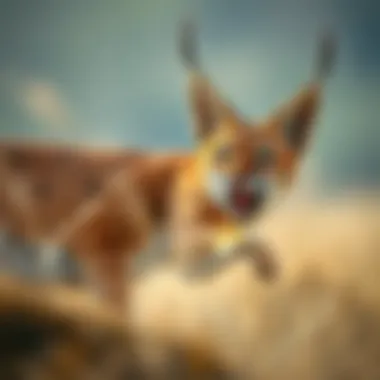
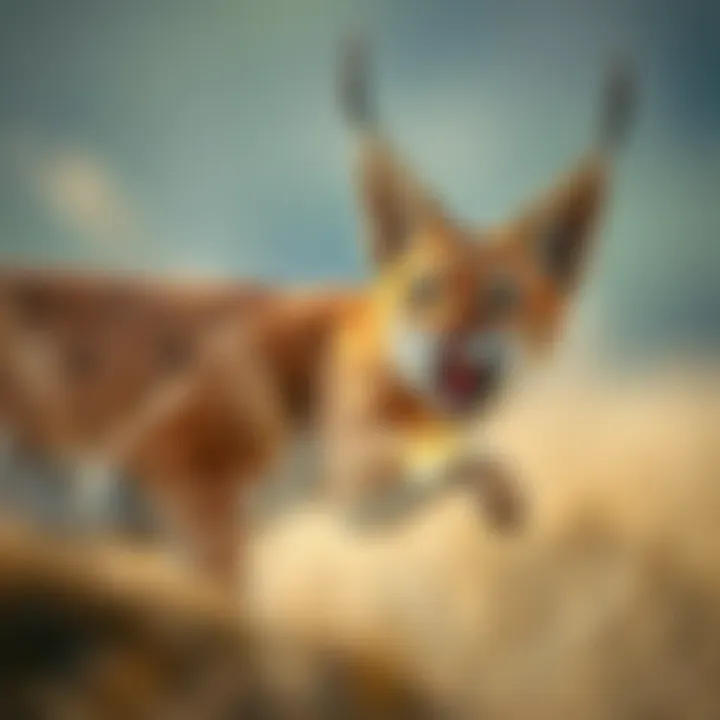
Understanding the types of habitats that the caracal occupies is central to grasping how this captivating feline survives and thrives across its diverse range. Each habitat offers unique resources and challenges, and examining these options gives insight into their ecological role and adaptability. Caracals are quite versatile, showing an impressive ability to adjust their behavior and hunting strategies according to the specific characteristics of their environment. This adaptability highlights their resilience in a world where habitats are increasingly impacted by human activity and climate change.
Savanna and Grasslands
Savannas and grasslands serve as a primary habitat for caracals, covering vast areas of Africa. In these open spaces, the tall grasses provide ample opportunity for the caracal to stalk prey, which includes a variety of small mammals and birds. The combination of wide-open terrain and patches of denser vegetation creates an ideal hunting ground.
Caracals, being ambush hunters, use the cover of the grass to their advantage. They often lie in wait for unsuspecting prey to wander into range. Some studies suggest that they can leap up to 3 meters in the air to catch birds in flight. The open nature of these habitats not only provides hunting opportunities but also broad visibility to spot approaching threats or competitors.
Arid and Semi-Arid Areas
The adaptability of the caracal is truly tested in arid and semi-arid regions, where rainfall is scant. These areas, often characterized by sparse vegetation and limited water sources, force the caracal to adapt its hunting and living habits. The caracal can often be seen prowling around rocky outcrops, which provide both shelter and vantage points for spotting prey.
In these extreme conditions, the caracal’s diet may shift to include more nocturnal species, such as rodents that are active during cooler night hours. Furthermore, their tawny fur provides excellent camouflage within the sandy and rocky landscape, enhancing their stealth when stalking prey. This adaptability to arid habitats allows caracals to make a living where many other species struggle.
Woodland and Forest Edges
Woodlands and forest edges present another distinctive environment for caracals. In these habitats, they often find abundant cover and a rich supply of smaller mammals, birds, and insects that thrive in bushy areas. The transition zone between open savanna and dense forest allows caracals to exploit resources from both habitats effectively.
Here, the vibrant underbrush, along with scattered trees, serves as an excellent maneuvering space. Caracals often use the shadows from the trees to stalk their prey. These areas are less disturbed by human activities due to their more inhospitable terrain, allowing caracal populations to flourish. Nonetheless, deforestation and land conversion pose severe threats to these locations, pushing caracals towards other, less suitable habitats.
Mountain Regions
Mountain regions add a fascinating layer to the caracal’s habitat preferences. In these elevated environments, the terrain is far more challenging, yet caracals exhibit significant adaptability. They are capable of navigating rocky slopes and utilizing elevation changes to their advantage.
In mountainous areas, the caracal’s diet may diversify, incorporating more large birds and smaller mammals that inhabit these rugged landscapes. The variation in altitude increases the range of species available, depending on the specific ecosystem. The cooler climate brings its own set of challenges and yet, somehow, the caracal has continually shown an ability to adjust.
"The versatility of the caracal across diverse habitats speaks to its role as a sentinel of ecological health. Its presence indicates thriving ecosystems, while its decline often forebodes ecological distress."
Overall, exploring the different types of habitats occupied by caracals provides essential insights into their behavioral ecology and their significant role within their ecosystems. Understanding their habitat preferences will aid conservation efforts, enabling us to create strategies to ensure that these remarkable cats continue to roam freely across their native landscapes.
Adaptations to Habitat
The adaptability of the caracal to its environment is a key aspect of its survival and success across various landscapes. Understanding how these remarkable felines adjust to their habitats sheds light on their ecological significance. Caracals’ adaptations are not merely physical; they encompass behavioral strategies critical for hunting, mating, and territory defense. The ability to thrive in diverse environments demonstrates their resilience and resourcefulness, which are essential in a world where habitat loss is an increasing concern.
Physical Adaptations
Ear Tufts and Hearing
Caracals are easily recognized by their striking ear tufts, which are not just for show; they serve functional purposes that enhance the cat's auditory capabilities. These tufts, a mix of elongated fur at the tips of their ears, help amplify sound, allowing caracals to detect even the faintest rustlings in their surroundings. This ability is crucial when hunting, as many of their prey, such as rodents and birds, rely on stealth to escape potential predators.
One standout trait is how these ear tufts interact with their environment. They can pick up sounds from various directions, providing the caracal with an acute awareness of potential meals or threats. The adaptability offered by their hearing makes them effective hunters even in densely vegetated areas where visibility is limited.
However, the ear tufts come with their quirks. In drier ecosystems, dust or debris can accumulate on their ears, temporarily hindering their hearing. Despite this, the overall advantages gained from their unique ear structure far outweigh any minor inconveniences.
Fur Coloration and Camouflage
The fur coloration of the caracal also plays a vital role in its ability to blend into different habitats, from the golden hues of savannas to the darker shades found in woodland regions. This natural camouflage is an evolutionary boon that allows them to hide from both prey and potential threats, ensuring higher success rates while hunting.
A caracal's coat is short and thick, with shades of tawny brown to reddish, which varies slightly depending on their habitat. The patterns help break up their silhouette following patterns in foliage or terrain, making them nearly invisible to other animals. This stealth is paramount in their hunting strategy, giving them an edge when stalking their prey.
That said, the unique fur coloration is inefficient in areas with dense undergrowth. In such places, caracals must rely more on their hunting prowess and agility than on ambush tactics. Nevertheless, their ability to adapt their strategies based on environmental conditions highlights their intelligence and flexibility in seeking food.
Hunting Strategies and Territory
Hunting is an adaptive process for the caracal. They employ a combination of tactics ranging from stealth and surprise attacks to ambushing prey from foliage. This flexibility makes them highly effective hunters, capable of taking down prey much larger than themselves, such as small antelope.
Territory is another aspect where adaptability shines. Caracals are solitary and territorial animals, marking their domain with scent markings. This technique communicates their presence to potential rivals and helps maintain boundaries among individuals. Interestingly, caracals can adjust the size of their territories based on the abundance of prey available, showcasing their ability to respond to their environment's ecological pressures. For example, in areas with plentiful food sources, territories may be smaller. Conversely, in regions with sparse prey, territories expand to ensure food availability.
Ultimately, the adaptability of the caracal underscores the cat's vital role in its ecosystem. As hunters, they contribute to the balance of their habitats, regulating populations of various prey species. Their unique attributes highlight that a successful predator not only relies on physical attributes but also on behavioral adaptability to thrive in ever-changing environments.
Ecological Role
The caracal plays an essential role in maintaining the ecological balance within its habitat. As a skilled predator, it influences local populations of various small to medium-sized mammals and birds, contributing to a dynamic predator-prey relationship. Understanding these dynamics is crucial for anyone interested in the delicate fabric of ecosystems the caracal inhabits.
Predator-Prey Dynamics
The hunting prowess of the caracal is remarkable and serves a vital function in its ecosystem. With keen eyesight and exceptional agility, these cats can leap up to three meters to catch birds mid-flight. Their diet primarily consists of rodents, small ungulates, and birds, which makes them a natural control mechanism for these populations. When a predator like the caracal thrives, it helps prevent overpopulation of these prey species, which could otherwise lead to overgrazing and habitat degradation.
In areas where the caracal exists, an intricate balance is maintained. For instance, if the caracal's population decreases due to habitat loss or hunting, prey species may proliferate unchecked, potentially causing rifts in the ecosystem. Thus, caracals not only sustain their populations through their predation habits but also play an indirect role in preserving their environments. This intricate balance highlights the interdependence of species within an ecosystem.
Impact on Biodiversity
Biodiversity benefits significantly from the presence of caracals. They fulfill a critical ecological niche that ensures various species can coexist in a balanced manner. A biodiversity-rich area, containing a variety of species, is often more resilient and better able to withstand environmental stresses. Caracals indirectly facilitate this process by regulating prey populations and ensuring that no single species dominates the local ecology.
When predator numbers, such as those of the caracal, decline, the ripple effects can lead to changes in species composition and reduced plant diversity. The caracal, through its predation patterns, helps many other species flourish, from plants to other animals.
Caracals also interact with other predators in their regions, including larger cats, which often leads to a healthy distribution of various predator species and fewer conflicts. Hence, safeguarding the caracal’s habitat is paramount—not just for their survival, but for the preservation of biodiversity.
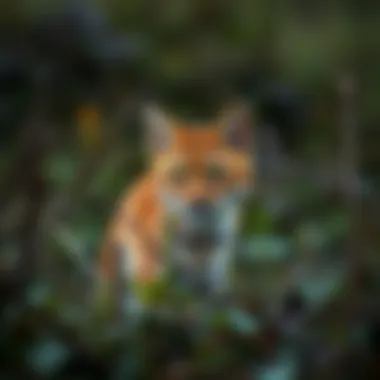

“The loss of one species can set off a domino effect, altering the entire habitat.”
In essence, the ecological role of the caracal is invaluable. They are not merely solitary hunters but pivotal figures in our ecosystems, influencing biodiversity and maintaining harmony within their environments. Acknowledging this role equips us with the understanding necessary for effective conservation efforts.
Conservation Status
The conservation status of the caracal is a crucial aspect of understanding its ecological presence and the challenges it faces in today’s rapidly changing world. The caracal walks a fine line between being a resilient species and being threatened by human actions, habitat degradation, and changing ecosystems. By focusing on the specific threats to its habitat, we can better grasp the necessity for targeted conservation efforts.
Threats to Habitat
Urbanization
Urbanization is a significant factor contributing to habitat loss for caracals. As cities expand and new developments spring up, the natural habitats of these wild cats shrink, leading to increased human-animal conflicts. The key characteristic of urbanization here is not just population growth but also land-use changes, which transform vast swathes of land into concrete jungles. This can be a tough sell for conservationists, as development often comes with promises of economic growth. However, the reality is that caracals, which thrive in wide-ranging territories, find their movements and hunting patterns disrupted.
Urban areas can be a double-edged sword; while they offer some benefits like reduced hunting pressures in highly populated areas, they simultaneously pose a significant barrier to the movement of wildlife, leading to inbreeding and population decline. In the light of this, it’s vital to strike a balance between urban expansion and ecosystem preservation to ensure that these beautiful cats don’t find themselves boxed in.
Agricultural Expansion
Agricultural expansion is another thorn in the side for caracals. As farmers clear land for crops and livestock, they encroach upon the natural habitats of these cats, stripping away essential resources they need to survive. The notable feature of agricultural expansion is its direct impact on prey availability and shelter for the caracals. The fields that once provided a diverse range of prey become monocultures that offer little to no sustenance for the caracal.
This shift can lead to increased competition among predators and sometimes drives caracals closer to human settlements, resulting in higher conflict rates. Although agriculture is fundamentally important for food production and livelihoods, its encroachment into wild habitats has adverse effects that cannot be overlooked. We need innovative agricultural practices that promote coexistence between farming and wildlife.
Climate Change
Climate change poses a looming threat to the habitats of the caracal, impacting both their ecological niche and food sources. One key characteristic of climate change is its unpredictable weather patterns, which result in droughts or extreme rainfall, conditions that alter habitats fundamentally. As temperatures rise, many of the grasslands and savannas that caracals favor may become less hospitable, leading to shifts in their range.
Caracals are adaptable, but rapid changes can outpace their ability to cope. The unique feature of climate change, coupled with human-induced habitat loss, compounds the challenges they already face. Temperature fluctuations can affect the productivity of their hunting grounds and the availability of prey species, forcing them to adapt quickly. The long-term preservation of caracal habitats hinges not just on local efforts but also on a broad commitment to combat climate change at all levels.
Conservation Efforts
Addressing these threats requires robust conservation efforts that go beyond mere protection of species. Collaborative approaches that involve local communities, government organizations, and international entities are essential.
Fostering awareness about the caracal’s role in maintaining the balance of ecosystems is equally important. Educational programs that highlight their ecological significance can engender support for conservation initiatives.
Helping communities develop wildlife-friendly practices, such as compensation for livestock losses due to predation, can also go a long way. Additionally, it’s vital that ongoing research informs conservation strategies, focusing on creating sustainable landscapes that allow both human activity and wildlife to thrive.
In the face of numerous challenges, habitat preservation remains a pivotal goal to ensure the survival of the caracal in the wild.
Utilizing all available resources—from community engagement to scientific research and policy-making—will ultimately determine the future of this resilient yet vulnerable species.
Future Challenges
Understanding the future challenges faced by the caracal is crucial for grasping how this species interacts with its habitat and the surrounding environment. The dynamics of our planet are shifting in numerous ways, and the caracal's survival and thriving are intricately tied to these changes. As habitats continue to evolve due to various factors, it is imperative to shed light on these transformations, paving the way for informed conservation initiatives.
Changing Ecosystems
Ecosystems are not static—it’s more like they are in a constant state of flux. With climate change, for instance, the patterns of rainfall, temperature, and even seasonal changes are undergoing substantial variations. Caracals, which primarily inhabit savannas and semi-arid regions, rely heavily on these ecosystems for prey availability and survival. As aridity increases or rainfalls become erratic, food sources can dwindle.
These shifts pose several threats:
- Prey Availability: As their habitat changes, the population of small to medium-sized mammals that serve as food may decrease or migrate, making it harder for caracals to hunt.
- Habitat Loss: New development projects may encroach on vital caracal territories. Urban spread, agricultural expansion, and other human activities further fragment these habitats, reducing the caracal’s range.
- Invasive Species: Changing habitats can also open doors for invasive species to take hold, competing with native wildlife for resources and further complicating the caracal's ability to thrive.
"The natural world is a delicate balance; a shift in one area can have a domino effect on others."
Importance of Habitat Preservation
Preserving the caracal's habitat is not just vital for this species; it's a linchpin for the entire ecosystem. By maintaining ecological integrity, we not only protect the caracal but also countless other species that share its environment. Here are key considerations about the importance of habitat preservation:
- Biodiversity Support: Healthy habitats sustain diverse species. When caracals have sufficient territory, they contribute to a balanced predator-prey dynamic, supporting broader biodiversity.
- Ecological Services: Healthy ecosystems provide invaluable services such as pollination, water filtration, and soil stability. Protecting spaces where caracals roam safeguards these essential functions.
- Cultural Value: Caracals hold cultural significance in various societies, embodying aspects of heritage and wildlife preservation that enrich human experience.
To maximize conservation efforts, strategic actions must be implemented, such as establishing protected areas, engaging local communities, and promoting sustainable land-use practices. Raising awareness about the plight of the caracal and the interconnectedness of species can galvanize support, ensuring that vibrant ecosystems endure for generations to come.
In summary, confronting future challenges demands a multifaceted approach, integrating habitat preservation into broader conservation strategies to guarantee that the caracal and its ecosystem not only survive but flourish in a changing world.
Finale
The discussion of the caracal's habitat shines a spotlight on several crucial aspects of its existence as a wild cat. In this exploration, we delved into various environments the caracal calls home—from savannas and grasslands to arid regions and mountainous areas. Each habitat presents unique challenges and opportunities, emphasizing the caracal's adaptability and resilience. Understanding these habitats is vital not just for appreciating the caracal's ecological role, but for recognizing the broader implications humans have on these environments.
Summary of Key Points
To recap, the caracal's habitat is characterized by:
- Diverse Environments: Occupying a range of landscapes across Africa, the Middle East, and Central Asia.
- Adaptations: Physical features like ear tufts and effective hunting strategies that facilitate survival in varied habitats.
- Ecological Importance: Their role as predators significantly influences local biodiversity, maintaining a balance within their ecosystem.
- Conservation Challenges: Threats from urbanization, climate change, and habitat loss present ongoing risks to caracal populations.
The survival of the caracal is deeply entwined with human actions—every choice we make can affect their habitats directly.
Call to Action for Conservation
With these key points in mind, it is imperative that as stewards of the environment, we take meaningful steps towards the conservation of the caracal and its habitats. Here are some actions individuals and communities can undertake to make a difference:
- Support Conservation Organizations: Engage with groups dedicated to wildlife preservation, such as the World Wildlife Fund (wwf.org) or local initiatives focusing on habitat restoration.
- Promote Sustainable Practices: Advocate for ecologically sound agricultural methods and sustainable land use that minimize habitat destruction.
- Increase Awareness: Educate others about the caracal's plight through social media, discussions, or local events focused on wildlife education.
- Participate in Citizen Science: Engage in projects that monitor wildlife populations and habitat conditions; programs like iNaturalist (inaturalist.org) can be a good start.
It is only through a collective effort that we can hope to preserve not just the caracal but entire ecosystems that play a vital role in our planet's health. Each action counts—let’s tread lightly and be responsible guardians of nature.







